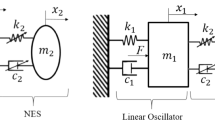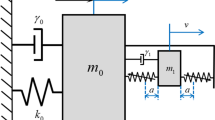Abstract
Nonlinear energy sinks (NESs) have become a research hotspot due to their frequency robustness, but the optimization problem under harmonic excitation has not been adequately addressed. In this paper, the response of a single-degree-of-freedom system with a cubic stiffness NES attached under harmonic excitation is simplified to 1:1 internal resonance through the harmonic balance method, and H∞ optimization is carried out on this basis. By comparing the frequency response curves (FRCs) of the system and the response of the system under the chirp excitation, the reliability of this approximation method is verified. Through the analysis of the fold bifurcations, the variation trend of the FRCs changing with the external excitation and the conditions for detached resonance curves to appear are obtained. The performance in three special cases is analyzed analytically, while the optimal parameters in general cases are analyzed numerically and fitted to obtain empirical formulas. The results show that the NES will fail applied on the undamped system due to a fixed point tending to infinity. When the external excitation is too large, the NES will amplify vibration of the linear system, and the damping of the NES has a very important influence on the vibration control if the damping of the system is relatively high. Finally, the performance of the NES is compared with the traditional linear vibration absorber (LVA). Although the best performance of the NES is not as good as the LVA, it can achieve multi-mode control under certain conditions.














Similar content being viewed by others
Data availability
The datasets generated during the current study are available from the corresponding author on reasonable request.
References
Vakakis, A.F., Gendelman, O.V., Bergman, L.A., McFarland, D.M., Kerschen, G., Lee, Y.S.: Nonlinear Targeted Energy Transfer in Mechanical and Structural Systems. Springer, New York (2008)
Ding, H., Chen, L.Q.: Designs, analysis, and applications of nonlinear energy sinks. Nonlinear Dyn. 100, 3061–3107 (2020)
Sapsis, T.P., Vakakis, A.F., Gendelman, O.V., Bergman, L.A., Kerschen, G., Quinn, D.D.: Efficiency of targeted energy transfers in coupled nonlinear oscillators associated with 1:1 resonance captures: part II, analytical study. J. Sound Vib. 325, 297–320 (2009)
Tripathi, A., Grover, P., Kalmár-Nagy, T.: On optimal performance of nonlinear energy sinks in multiple-degree-of-freedom systems. J. Sound Vib. 388, 272–297 (2017)
Boroson, E., Missoum, S.: Stochastic optimization of nonlinear energy sinks. Struct. Multidiscip. Optim. 55, 633–646 (2017)
Oliva, M., Barone, G., Lo Iacono, F., Navarra, G.: Nonlinear energy sink and Eurocode 8: An optimal design approach based on elastic response spectra. Eng. Struct. 221, 111020 (2020)
Oliva, M., Barone, G., Navarra, G.: Optimal design of nonlinear energy sinks for SDOF structures subjected to white noise base excitations. Eng. Struct. 145, 135–152 (2017)
Gendelman, O.V., Starosvetsky, Y., Feldman, M.: Attractors of harmonically forced linear oscillator with attached nonlinear energy sink I: description of response regimes. Nonlinear Dyn. 51, 31–46 (2008)
Starosvetsky, Y., Gendelman, O.V.: Attractors of harmonically forced linear oscillator with attached nonlinear energy sink. II: optimization of a nonlinear vibration absorber. Nonlinear Dyn. 51, 47–57 (2008)
Wu, Z., Seguy, S., Paredes, M.: Basic constraints for design optimization of cubic and bistable nonlinear energy sink. J. Vib. Acoust. Trans. ASME. 144(2), 021003 (2022)
Guo, H., Yang, T., Chen, Y., Chen, L.Q.: Singularity analysis on vibration reduction of a nonlinear energy sink system. Mech. Syst. Signal Process. 173, 109074 (2022)
Gourc, E., Michon, G., Seguy, S., Berlioz, A.: Experimental investigation and design optimization of targeted energy transfer under periodic forcing. J. Vib. Acoust. Trans. ASME. 136(2), 021021 (2014)
Qiu, D., Seguy, S., Paredes, M.: Tuned nonlinear energy sink with conical spring: design theory and sensitivity analysis. J. Mech. Des. Trans. ASME. 140(1), 011404 (2018)
Zang, J., Zhang, Y.W., Ding, H., Yang, T.Z., Chen, L.Q.: The evaluation of a nonlinear energy sink absorber based on the transmissibility. Mech. Syst. Signal Process. 125, 99–122 (2019)
Zhao, Y., Du, J., Liu, Y.: Vibration suppression and dynamic behavior analysis of an axially loaded beam with NES and nonlinear elastic supports. JVC/J. Vib. Control 2021(29), 844–857 (2023)
Zhou, J., Xu, M., Yang, Z., Gu, Y.: Suppressing nonlinear aeroelastic response of laminated composite panels in supersonic airflows using a nonlinear energy sink. Chinese J. Aeronaut. 34, 376–385 (2021)
Aghayari, J., Bab, S., Safarpour, P., Rahi, A.: A novel modal vibration reduction of a disk-blades of a turbine using nonlinear energy sinks on the disk. Mech. Mach. Theory. 155, 104048 (2021)
Chirathalattu, A.T., Santhosh, B., Bose, C., Philip, R., Balaram, B.: Passive suppression of vortex-induced vibrations using a nonlinear energy sink—numerical and analytical perspective. Mech. Syst. Signal Process. 182, 109556 (2023)
Liu, G., Chen, G., Cui, F.: Vibration suppression for beam-like repeating lattice structure based on equivalent model by a nonlinear energy sink. Math. Probl. Eng. 2021, 1–15 (2021). https://doi.org/10.1155/2021/6659598
Friskney, B., Alevras, P., Londhe, S., Theodossiades, S., McFarland, D.M.: A nonlinear energy sink design to attenuate the torsional oscillations of lightly loaded gear pairs. Appl. Sci. 12, 6778 (2022)
Haris, A., Alevras, P., Mohammadpour, M., Theodossiades, S., Mahony, M.O.: Design and validation of a nonlinear vibration absorber to attenuate torsional oscillations of propulsion systems. Nonlinear Dyn. 100(1), 33–49 (2020). https://doi.org/10.1007/s11071-020-05502-z
Vaurigaud, B., Ture Savadkoohi, A., Lamarque, C.H.: Efficient targeted energy transfer with parallel nonlinear energy sinks: theory and experiments. J. Comput. Nonlinear Dyn. 6(4), 041005 (2011)
Wierschem, N.E., Quinn, D.D., Hubbard, S.A., Al-Shudeifat, M.A., McFarland, D.M., Luo, J., Fahnestock, L.A., Spencer, B.F., Vakakis, A.F., Bergman, L.A.: Passive damping enhancement of a two-degree-of-freedom system through a strongly nonlinear two-degree-of-freedom attachment. J. Sound Vib. 331, 5393–5407 (2012)
Chen, J., Zhang, W., Liu, J., Hu, W.: Vibration absorption of parallel-coupled nonlinear energy sink under shock and harmonic excitations. Appl. Math. Mech. 42, 1135–1154 (2021)
Kong, X., Li, H., Wu, C.: Dynamics of 1-dof and 2-dof energy sink with geometrically nonlinear damping: application to vibration suppression. Nonlinear Dyn. 91, 733–754 (2018)
Zhang, Y., Kong, X., Yue, C., Xiong, H.: Dynamic analysis of 1-dof and 2-dof nonlinear energy sink with geometrically nonlinear damping and combined stiffness. Nonlinear Dyn. 105, 167–190 (2021)
Zhang, Y., Kong, X., Yue, C.: Vibration analysis of a new nonlinear energy sink under impulsive load and harmonic excitation. Commun. Nonlinear Sci. Numer. Simul. 116, 106837 (2023)
Zhang, Y.W., Lu, Y.N., Zhang, W., Teng, Y.Y., Yang, H.X., Yang, T.Z., Chen, L.Q.: Nonlinear energy sink with inerter. Mech. Syst. Signal Process. 125, 52–64 (2019)
Al-Shudeifat, M.A.: Highly efficient nonlinear energy sink. Nonlinear Dyn. 76, 1905–1920 (2014)
Liu, Y., Chen, G., Tan, X.: Dynamic analysis of the nonlinear energy sink with local and global potentials: geometrically nonlinear damping. Nonlinear Dyn. 101, 2157–2180 (2020)
Seydel, R.: Practical Bifurcation and Stability Analysis, 3rd edn. Springer, New York (2010)
Gatti, G.: Uncovering inner detached resonance curves in coupled oscillators with nonlinearity. J. Sound Vib. 372, 239–254 (2016)
Lagarias, J.C., Reeds, J.A., Wright, M.H., Wright, P.E.: Convergence properties of the Nelder–Mead simplex method in low dimensions. SIAM J. Optim. 9, 112–147 (1998)
Asami, T., Nishihara, O., Baz, A.M.: Analytical solutions to H∞ and H2 optimization of dynamic vibration absorbers attached to damped linear systems. J. Vib. Acoust. Trans. ASME. 124, 284–295 (2002)
Funding
Authors may acknowledge financial support by National Natural Science Foundation of China (NSFC) (Grant Nos. 51875336 and 12121002), National Science and Technology Major Project (Grant No. J2019-II-0013-0034), Professor of Special Appointment (Eastern Scholar) at Shanghai Institutions of Higher Learning (Grant No. SHDP2022) and the Basic Research Project of Science and Technology of Shanghai (No. 20JC1415000).
Author information
Authors and Affiliations
Contributions
All authors contributed to the study conception and design. Material preparation, data collection and analysis were performed by ZZ, XH and ZS. YY helped to revise the manuscript. The first draft of the manuscript was written by ZZ, and all authors commented on previous versions of the manuscript. All authors read and approved the final manuscript.
Corresponding author
Ethics declarations
Conflict of interest
The authors declare that they have no known competing financial interests or personal relationships that could have appeared to influence the work reported in this paper.
Additional information
Publisher's Note
Springer Nature remains neutral with regard to jurisdictional claims in published maps and institutional affiliations.
Appendices
Appendix A
Stability analysis
Superimpose a small perturbation on the solution of periodic response
Substitute Eq. (A.1) into Eq. (2), and ignoring the infinitesimals obtains
The perturbation is assumed to be
where \(\phi_{u} \left( \tau \right) = C_{u} \cos \left( {\Omega \tau } \right) + S_{u} \sin \left( {\Omega \tau } \right),\;\phi_{w} \left( \tau \right) = C_{w} \cos \left( {\Omega \tau } \right) + S_{w} \sin \left( {\Omega \tau } \right)\)
Substituting Eq. (A.3) into Eq. (A.2) yields
Using the Galerkin method to process Eq. (A.4) obtains a set of linear algebraic equations
where \(\mu_{1} = \frac{{3\beta_{1} \left[ {3\Re \left( W \right)^{2} + \Im \left( W \right)^{2} } \right]}}{4},\;\mu_{2} = \frac{{3\beta_{1} \Re \left( W \right)\Im \left( W \right)}}{2},\;\mu_{3} = \frac{{3\beta_{1} \left[ {3\Im \left( W \right)^{2} + \Re \left( W \right)^{2} } \right]}}{4}.\)
In order to ensure that there are nonzero solutions to Eq. (A.5), the determinant of the matrix on the left must be 0. From this, the Floquet exponents λ can be solved, which can be used to judge the stability of the periodic solution. If \(\Re \left( \lambda \right) < 0\), the solution is stable. If \(\Re \left( \lambda \right) = 0\) and \(\Im \left( \lambda \right) = 0\), this solution is a point of fold bifurcations. If \(\Re \left( \lambda \right) = 0,\) \(2\pi \Im \left( \lambda \right)/\Omega\) is not equal to 0 or π, indicating that Hopf bifurcations occur.
Rights and permissions
Springer Nature or its licensor (e.g. a society or other partner) holds exclusive rights to this article under a publishing agreement with the author(s) or other rightsholder(s); author self-archiving of the accepted manuscript version of this article is solely governed by the terms of such publishing agreement and applicable law.
About this article
Cite this article
Zheng, Z., Huang, X., Su, Z. et al. H∞ optimization of cubic stiffness nonlinear energy sink attached to a linear system. Nonlinear Dyn 111, 15653–15673 (2023). https://doi.org/10.1007/s11071-023-08690-6
Received:
Accepted:
Published:
Issue Date:
DOI: https://doi.org/10.1007/s11071-023-08690-6




